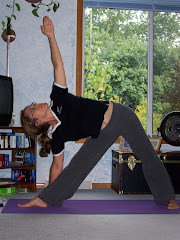As I review my notes and see what I can recall from just over a week ago, I see the word MANTRA. All in capitals.
Thomas Ashley-Farrand breaks the word Mantra into its Sanskrit roots: manas (mind) and trai (device). It is very interesting that he says to truly study mantra, one must include a study of anatomy. Perhaps, this is to verify that the sounds are made in such a manner as to stimulate certain meridians or nadis (energy channels) in the body. Rod Stryker commented that "Mantra is used to still the action of the mind by focusing on an object, in this case the object in the mantra."
For those new to mantra, it is basically the repeating of a sound or phrase, usually in Sanskrit. Typically a mala (string of beads, usually 108 bead long) is used to count the number of repetitions of a mantra.
About 3 years ago, a student of Swami Rama's gave me a personal mantra. I tried using it for a total of about 3 months, and then abandoned it. Mala meditation just didn't seem to "work" for me. I was constantly distracted by the moving beads and unable to fully surrender to Source while repeating my mantra. Other meditation techniques brought me to far deeper states of inner awareness.
However, Rod was so "gung hoe" about mala and the use of mantra, that I will give it another try.
Here were some insights that he shared that will perhaps help you on your path:
1. The beads keep you just aware enough to stay present. Without them it is easier for the mind to "float" in various directions.
2. When repeating the mantra, over time the mantra may slip away and the mind rests. Allow this to happen. This is your connection to Source or Higher Awareness. When the mind begins to wander, come back to repeating the mantra. Remember: The mantra is simply a tool to reach this connection.
3. Japa is to repeat the mantra without stopping. The mantra must be silent in such a practice. The reason being that eventually you are not consciously repeating the mantra. Rather, you begin to "hear" it. In the case of Japa, do not use a melody, as you might when chanting the mantra aloud. Simply because it takes too long.
4. To begin the Japa practice, start by saying the mantra silently and stop when you feel inner awareness growing. Continue the mantra, if the mind gets distracted. Over time Nada or the sound of creation will arrive. From this place fully surrender. The more you listen within and let go, the easier it is to here the mantra arise out of this silence. It will arise non-linear, coming from a single point. One of the keys here is to not consciously think the sound when you hear it.
Pretty amazing stuff! Admittedly, I consciously think the mantra, and so far have not heard it. However, check out http://www.yogamag.net/archives/2004/6dec04/nada.shtml for a wonderful definition of sound and nada.
Finally, are you looking for a mantra? If you don't have a personal mantra, the Gayatri is extremely powerful. Or check out Amazon for various CD's on mantras. I highly recommend anything by Thomas Ashley-Farrand. His teaching method and knowledge are both of the highest caliber.
If you do experience the "sound" of the non-linear mantra, let me know. I'd love to hear about it!
Namaste,
Kris
http://www.totalhealthyoga.com/
PS On June 19, 6:30-8:30 pm, in Menomonee Falls, WI, I'll be holding a Mala Meditation training. If you are interested in attending, please email me at Kris@TotalHealthYoga.com.








